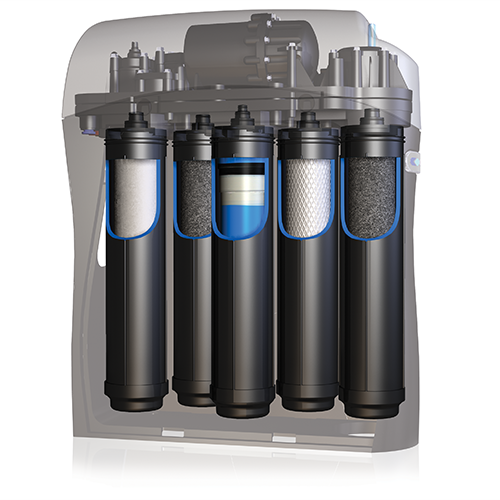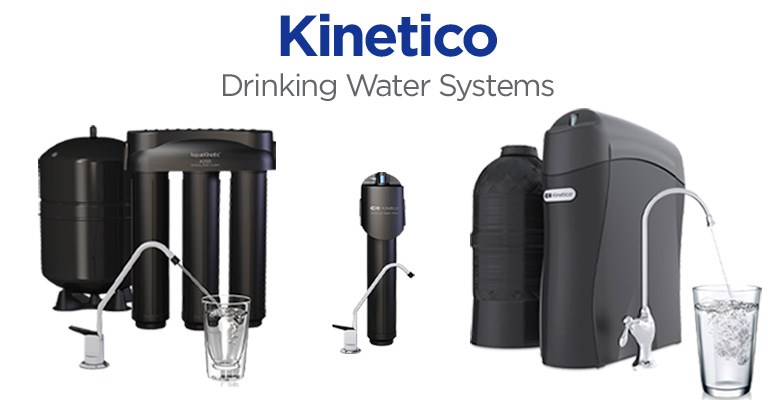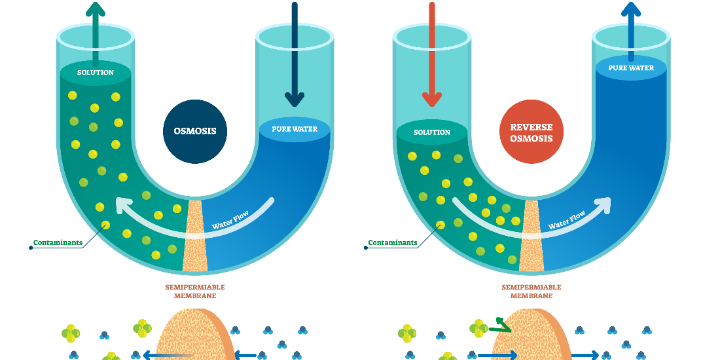What is Reverse Osmosis?
Reverse osmosis, is, or RO, is a water treatment process in which water passes through a semi-permeable membrane. Reverse osmosis is known for producing great-tasting pure water and being highly effective for contaminant removal.
How does RO work?

The reverse osmosis process uses a semi-permeable membrane to separate water from contaminants. “Semi-permeable” means that some things can pass through and others can’t. A familiar example would be your furnace’s air filter. A key difference in semi-permeable membranes for water treatment is that they allow passage based on the size of the particle and its molecular charge.
Typical air filters separate the contaminants exclusively by size. Holes, or pores, in the RO membrane are just big enough for the passage of a water molecule. Even small particles such as tobacco smoke or paint pigments are too big to flow through an RO membrane. At this point, because the membrane only lets certain molecules pass through, there is some waste. The waste, a highly concentrated solution of contaminants, is sent to the drain. You are left with virtually contaminant-free, clean water that makes it through the membrane. This is called a permeate stream, or as we like to say, great-tasting, filtered water.
Reverse osmosis technology relies on pressure to push the water molecules through the membrane. Water pressure varies by water source. City water is supplied between 40 and 100 psi (pounds per square inch). Well water is delivered between 20 and 60 psi, depending on your pump. The production rate of the reverse osmosis membrane is dependent on factors such as temperature, pressure and Total Dissolved Solids (TDS) levels. Since reverse osmosis works slowly, most RO systems include a storage tank that collects treated water. This feature is included so you can fill your glass or pitcher with clean water whenever you want it.
Because reverse osmosis water is so pure, it can pick up bad tastes and odors from the storage tank’s bladder or walls if it is stored for long periods of time. Running the water through a postfilter once it leaves the storage tank will remove residual tastes or odors before the water is dispensed.
What are the benefits of Kinetico Reverse Osmosis?
Kinetico offers reverse osmosis systems that are third-party certified to reduce more contaminants than other comparable systems. We also provide customizable RO systems that allow you to include filter cartridges for specific contaminant removal or to add minerals for taste. Whether your home needs a point-of-entry reverse osmosis system to remove impurities from all the water that enters your home, or a point-of-use reverse osmosis system to provide your family with high-quality, contaminant-free water for drinking and cooking, Kinetico has an option to meet your needs.
Featured Reverse Osmosis Water Products
THE KINETICO K5 DRINKING WATER STATION

The Kinetico K5 Drinking Water Station is a seven-stage reverse osmosis system featuring QuickFlo® technology to provide a constant flow of high-quality water whenever you need it. In fact, Kinetico’s K5 produces more water faster than any other reverse osmosis system in its class. The K5 is also one of the few reverse osmosis systems that is third-party certified for PFOS/PFOA removal.
THE KINETICO AQUAKINETIC A200 DRINKING WATER SYSTEM

The Kinetico A200 is a five-stage reverse osmosis system that provides your family with an economical way to improve the quality of your drinking water. The AquaKinetic A200 produces higher quality water at a faster rate than comparable systems. It is also certified to significantly reduce the levels of many unwanted contaminants like arsenic, chromium, lead and more.
CONTACT KARSARE WATER SYSTEMS
Reach out to us get a quote specific to your water needs for your home, business or industry. When you take this step, you can have peace of mind about your health and your environmental footprint.







